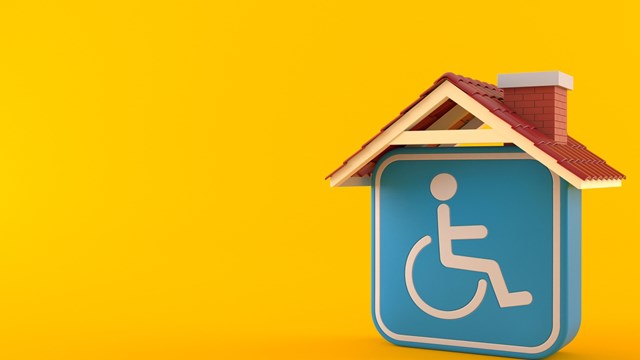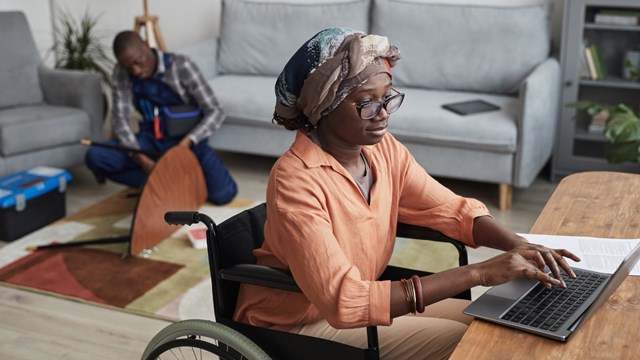The city can be a tough place to navigate even for the most able-bodied New Yorkers. For the elderly, those with disabilities, or anyone whose mobility has been compromised by illness or injury—even temporarily—getting into their own building can feel like a monumental task.
One law—specifically Title III of the Americans with Disabilities Act of 1990 —states that owners of certain buildings must remove barriers and provide people with disabilities with access equal to or similar to that available to the general public. Another law administered by the New York City Commission on Human Rights is the city’s Human Rights Law. This law also protects the rights of people with disabilities by requiring that landlords and management of co-ops and condominiums reasonably accommodate the needs of disabled tenants, shareholders or owners.
The city’s Human Rights Law protects the rights of people with disabilities by requiring that landlords, co-ops, and condos reasonably accommodate the needs of disabled tenants, shareholders or owners. Reasonable accommodation can be structural, such as a ramp at the primary entrance to provide wheelchair access, or installing grab-bars in bathrooms. They can also involve policy or rule changes, such as permitting a tenant who is blind or has a psychological disability to have a guide dog or a companion animal, despite a building’s “no pets” policy. The law provides guidance in assessing requests for reasonable accommodation, taking into account the nature and cost of the proposed accommodation and the financial resources of the landlord or building.
Help for All
As with many laws however, deciphering the ADA’s legalese can be complicated—and not fully understanding the law’s applications can result in accidental noncompliance. For example, in some cases, managers in the city’s older buildings mistakenly think they are exempt from these laws, believing that the laws are solely meant for new construction. Others may be baffled by the technical requirements of these laws, and still others equate accessibility with big budgets that they may not have at their disposal.
To help make the process smoother, there are several city-based organizations and offices where residents, building management and landlords can turn to for assistance deciphering the laws and ultimately complying with the ADA. The New York City Commission on Human Rights Law Enforcement Bureau and the Mayor’s Office for People with Disabilities can be contacted for assistance or if a resident has been rejected after making an accessibility request.
“Under the rules of the ADA, the biggest problem we face is the belief that older buildings are grandfathered out and thus not required to make changes,” says Avery Mehlman, deputy commissioner of the New York City Commission on Human Rights (CCHR) Law Enforcement Bureau. “But under the law, every building that can be made accessible in a reasonable fashion—if there is someone there that needs it—must be made accessible.
According to the City Human Rights Law, disabled residents who need an accommodation should inform the landlord and identify the type of accommodation needed. A note from the doctor or other health care professional may be required, but medical records are not necessarily required.
When Problems Arise
Unfortunately, in the worst case scenarios, some managers and owners occasionally refuse to make required exterior alterations for disabled residents, leading to dissatisfied occupants, possible litigation and hefty fines.
“We want to try and intervene without necessitating the firing off of a complaint and litigation,” says Mehlman. “The individual that is disabled needs the accommodation today, so we reach out to the housing provider immediately and ask for the particular location to be made accessible.”
There are two items to consider when reviewing a resident’s request, Mehlman continues. First, does the resident need the exterior of the particular location to be made accessible? And second, is it reasonable—both financially and physically—for the building to make that accommodation?
“Even when people have best intentions, there are still obstacles to creating a solution, especially in an old high-rise city building,” says Matthew Sapolin, executive director of the Mayor’s Office for People with Disabilities.
“For example, some buildings are too close to the street. Others have property lines that co-mingle or bump up against other properties, and sometimes the basement entrance is right up against the building and you can’t ramp over it. Barring those issues, we will enforce the law and push it as far as we need to go, even try it in front of an administrative judge to order the building to make those changes.”
In certain situations, when making the building accessible is simply not possible—when an elevator is a structural impossibility in a given building, for example—Mehlman says that if the owner owns another building with available ground floor residences, the tenant may be relocated as part of their reasonable accommodation.
If the managing agent or the owners refuse to comply with the mayor’s office, the case is then referred to the CCHR. Those who refuse a hearing before the CCHR will have a complaint filed against the building. “They have 30 days to comply or an investigation will be initiated,” says Mehlman.
In the past four years, the CCHR has successfully provided accessibility in over 500 residential buildings throughout the city—but it’s important to note that not all requests are automatically approved. The mayor’s office can grant waivers to buildings and boards when a request for accessibility alterations outstrips anything the building is able to provide, either structurally or financially.
“Space requirements and economic hardship are two of the reasons why a request can be waived,” says Sapolin. But with two architects on staff, the office considers all possible technical alterations before granting a waiver.
In the rare event that a request continues to be refused, the case may be send to the Department of Justice (DOJ), which relies on a group known as the Key Bridge Foundation to mediate a solution. The foundation is a non-profit organization underwritten by the DOJ and set up to handle complaints filed with the DOJ under Title III of the Americans with Disabilities Act.
According to the DOJ website, courts may levy civil penalties only in cases brought by the DOJ—not by private litigants. The department only seeks such penalties when the violation is substantial and the business has shown bad faith in failing to comply. Bad faith can take many forms, including hostile acts against people with disabilities, a long-term failure to even inquire into what the ADA requires, or sustained resistance to voluntary compliance.
The DOJ also considers the size of a business and it’s resources in determining whether civil penalties are appropriate. Civil penalties may not be assessed in cases against state or local governments or employers.
Compliance 101
If a co-op or building wants to—or has to—comply with an ADA-related request, there are several options for exterior accessibility, all very affordable, according to Ron Ratell, the strategic business unit manager for Automated Openings and ADA Marketing manager at Ingersoll Rand Security Technologies in Montvale, New Jersey.
First, an accessible opening means providing a door with a minimum of 32 inches clear opening, easily manipulated handles, a maximum opening force, a minimum closing time, and the capability of opening to at least 90 degrees. The maximum opening force is determined by the building’s geography.
“It’s determined by the local climate and wind conditions,” says Ratell. “For example, in Minneapolis where it’s cold and windy, you are going to have a heavier force to the door, but in Florida there won’t be as much force. The beauty of installing automatic doors is that you don’t need any force requirements.”
Ratell also explains that becoming ADA compliant is very affordable. “If an owner or landlord wants to make the building ADA-compliant, you can do so for less than $100 up to just a few thousand,” he says. “If doorknobs are not ADA compliant, they can be changed to levers for $30 to $50 installed.”
According to product information from Ingersoll Rand, handles, locks, latches pulls and other door hardware must be easily operable, must operate easily with one hand, without grasping tightly, or twisting the wrist to operate—lever, push or “U” shaped handles are recommended. This hardware must not be higher than 48 inches off the floor, and must be exposed and usable from both sides of the door. Doors with manual closers must not close faster than three seconds from 70 degrees to three inches from the latch. The maximum open force for sliding, folding and swinging interior doors is five pounds; automated doors are exempt.
Ratell also explains that an automatic door closer can also be installed for between $30 and $50. A low-energy power operator, or automatic door, can cost from $1,000 to $3,000 per door. “There are many ways you can activate the door,” says Ratell. “For example, you can activate it with a remote or a sensor. There are also even more high-end products like card swipes and fingerprint readings to open a door.”
According to Ratell, automatic doors can save buildings money by greatly lowering the cost of remodeling, but if a few thousand dollars is still too steep for a building’s bottom line, financial help is available.
“If we require a building to make alterations, we’ve determined that they can afford it,” says Mehlman. “But if they still can’t, we can also help to locate federal funds and grant funds. Federal tax incentives are available to help meet the cost of ADA compliance.” He adds that if a business has a revenue of less than $1 million or less than 30 full-time employees, it may be eligible for a tax credit equal to 50 percent of the eligible accessibility-related expenditures for the year, up to a maximum of $10,250. Installing a handicapped-accessible ramp, for example, experts say, could cost anywhere from a few thousand dollars to tens of thousands.
But in the end, the cost of ADA compliance is far less than the cost—both in terms of money and community goodwill—of noncompliance. By easing the stress on their less able-bodied residents, boards and managers can raise the sense of community cohesiveness in their buildings and let residents know that they’re all valued—regardless of their mobility.
Lisa Iannucci is a freelance writer based in Poughkeepsie, New York.







5 Comments
Leave a Comment